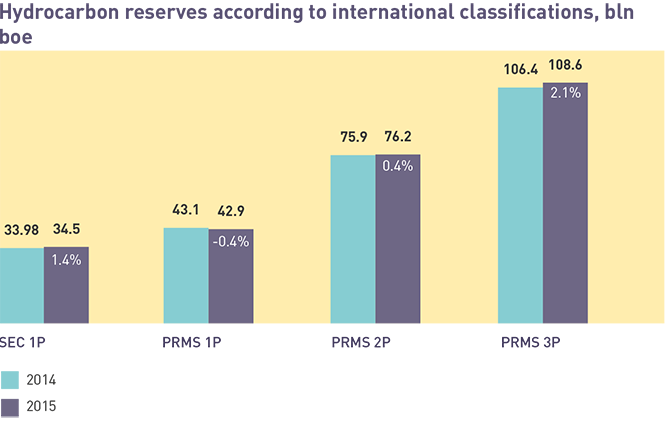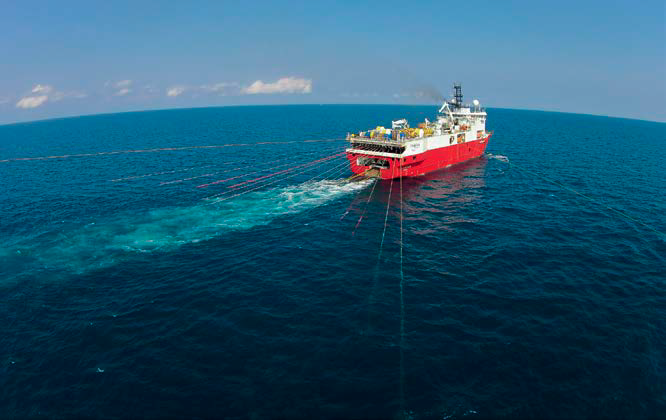ROSNEFT REITERATED ITS LEADERSHIP IN RESOURCE BASE AMOUNT AND EFFICIENCY OF EXPLORATION IN 2015.THE COMPANY CONDUCTED EXPLORATION IN ALL RUSSIAN EXTRACTING REGIONS, INCLUDING THE RUSSIAN FAR EAST, EAST AND WEST SIBERIA, VOLGA — URALS REGION, timan pechora, AND SOUTH OF RUSSIA.
Key achievements in reserve replacement:
- 11.5 bln t of oil and condensate and 7.5 tcm of gas represent Rosneft residual recoverable ABC1+C2 reserves as of the end 2015.
- 429 mmtoe of reserve replacement for ABC1 hydrocarbon reserves;
- 168 % of production replacement with reserves increment;
- 50 exploration wells were completed (with 119,000 m drilled);
- 84 % — the record success rate in exploration drilling;
- Seven new fields and 117 new deposits with total C1+C21;
- Reserves of 232 mmtoe were discovered as a result of exploration;
- The reserves life with the current production level is 46 years;
- The Company’s license pool consists of 821 licenses, including 52 offshore licenses. A total of 27 subsoil areas were acquired from open acreage throughout 2015, 17 covered by licenses.



Onshore exploration
2015 exploration program was performed at a high quality level with 50 exploration wells completed and 119,000 m drilled. The exploration success rate reached 84 % (record high for the last five years). 2D seismic surveys were completed across over 2,000 linear km (+ 70 % YOY) and 3D seismic surveys covered over 6,000 sq. km.
West Siberia
Reserves increment in West Siberia was at 94.7 mmt of oil and 118.1 bcm of gas. 95 % of 22 exploration wells were successful. 56 new deposits were discovered with total АВС1+С2 reserves at 184 mmtoe, including four new deposits with RN-Yuganskneftegaz LLC АВС1+С2 reserves with 136 mmtoe as a result of deepening production wells at the Priobskoye and Malobalykskoye License Areas and drilling of an exploration well at the Chupalsky License Area.
East Siberia and the Russian Far East
The overall increase in reserves in East Siberia and the Russian Far East approximated 19.2 mmt of crude and 36.4 bcm of gas. Seven exploration wells were success rate with and 100 % complete. Six new deposits with 33 mmt were discovered.
Taas-Yuriakh Neftegazodobycha LLC, Rosneft subsidiary, received a commercial oil inflow from the potentially productive deposits of the Arylakh horizon. This became possible after the complete drilling of 110-Р exploration well at the Srednebotubinskoye field under the exploration plan in Yakutia. According to the preliminary estimate, increased С1+С2 reserves will exceed 10 mmt of crude oil. The reserve volumes are to be updated based on the results of the 2015 /16 exploration and production well testing program and to be booked in the National Register.
VCNG started test operation at the North Danilovskaya field in the Irkutsk Region.
Volga–Urals Region, Timan Pechora, and Southern Federal District
The overall increase in reserves in the Volga–Urals Region, Timan Pechora, and Southern Federal District approximated 28.7 mmt of oil and 4.0 bcm of gas. A total of 21 exploration wells were SR with 70 % complete. Seven fields, including L nyanoye, Travninskoye, Erikleiskoye, West Shpilskoye, Kamelikskoye, West Perelyubskoye (Samara and Saratov Oblasts), and Agachiulskoye (Republic of Dagestan) fields, and 55 new deposits and total reserves of 14.7 mmtoe were discovered.
The first exploration well was drilled and tested in Timano-Pechora in the Berganty-Mylsky License Area, commercial hydrocarbon inflows were produced. There are plans to book Nertsetinsky field reserves in the National Register in 2016.
The first 2D ultra-dense seismic surveys were conducted in the license areas of JSC Dagneftegaz and JSC RN-Ingushetia in the North Caucasian Federal District. This method, allows to improve the quality of exploration approach, as compared to previous years.
The largest field discovered in the Volga Urals Province was the Kamelikskoye field. The field was discovered as the result of exploration well testing, the produced gas condensate flow exceeded 300 cm /day.
The exploration drilling in the Saratov Oblast resulted in the discovery of a new oil-saturated interval in the Pertinsky horizon (Upper Devon) of the Cheremushkinskaya area. The oil inflow reached 38 cm /day. The gas and condensate influx rates at the Kozhevskaya area reached 200 th. cm /day and up to 110 cm /day, respectively. In 2016, two of the discovered fields are planned to be booked in the National Register. These discoveries open a new potential in the Saratov region for further exploration.
Stable resources replacement
reserves life at current production
discovered in 2015
As of the end of 2015, Rosneft residual recoverable ABC1+C2 reserves (IFRS) amounted to to 11.5 bln t of oil and gas condensate and 7.5 tcm of gas.
The replacement of commercial ABC1 hydrocarbon reserves, taking into account acquisitions, totals 429 mmtoe, or 168 % of the production volumes in the Russian Federation. The reserves life based on the current production level amounts to 46 years.
One of the Company’s number one priorities is an expansion of its resource base. Successful exploration resulted in the discovery of seven fields and 117 new deposits (taking into account projects implemented in partnerships). The total discovered reserves approximate 232 mmtoe.
The growth of ABC1 reserves driven by prospecting amounted to 276 mmtoe in 2015.
INDEPENDENT INTERNATIONAL AUDIT OF RESERVES
HYDROCARBON RESERVES REPLACEMENT mmtoe ACCORDING TO SEC CLASSIFICATION
3P RESERVES AS OF THE END 2015 (+2 % TO 2014 LEVEL), PRMS 3P CATEGORY
In 2015, Rosneft reaffirmed its leadership among other world’s public oil companies in terms of proven hydrocarbon reserves and hydrocarbon resource base.
As of December 31, 2015, the proven hydrocarbon reserves of Rosneft approximated 34.5 bln boe (about 4.7 bln toe) based on the findings of an audit conducted by DeGolyer & MacNaughton using the SEC (U.S. Securities and Exchange Commission) classification providing for the evaluation through the end of profitable field development. Hydrocarbon liquids (oil, condensate, and NGL) and gas reserves approximated 24.7 bln bbl (3.3 bln t and 56.8 tcf (1.6 tcm) respectively.
The hydrocarbon reserves replacement in 2015, was 124 % according to SEC classification. Hydrocarbon reserves increased by 488 mm boe (59 mmtoe). According to SEC, Rosneft proven hydrocarbon reserves in 2015 were sufficient for 19 years of production.
According to PRMS (Petroleum Resources Management System), 1P hydrocarbon reserves as of December 31, 2015 amounted to 43 bln boe (5.8 bln toe), including 29.8 bln bbl (4.0 bln t) of hydrocarbon liquids (oil, condensate, and NGL) and 76.3 tcf (2.2 tcm) of gas; 2Р reserves were 76.2 bln boe (10.3 bln toe), including 53.7 bln bbl (7.2 bln t) of hydrocarbon liquids (oil, condensate, and NGL) and 130.3 tcf (3.7 tcm) of gas; 3Р reserves amounted to 108.6 bln boe (14.7 bln toe), including 79.5 bln bbl (10.7 bln t) of hydrocarbon liquids (oil, condensate, and NGL) and 169 tcf (4.8 tcm) of gas. The total 3P reserves grew by 2 % in 2015.


